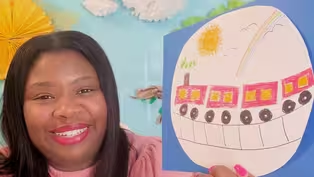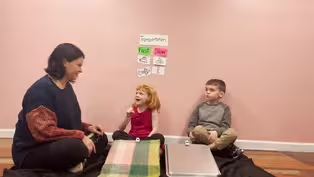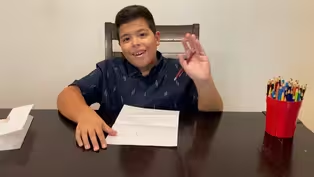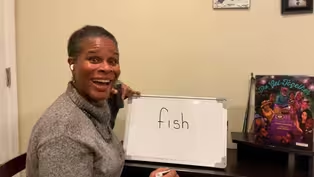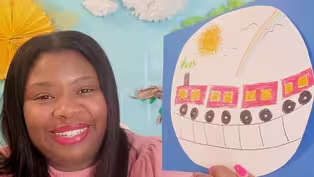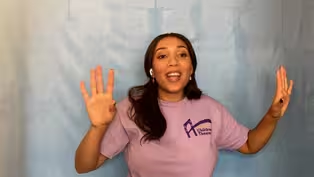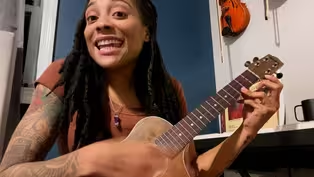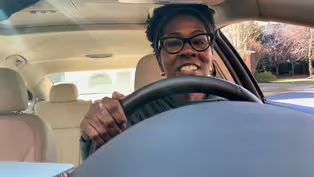
Do You Hear the “ch” in Choo Choo?
4/20/2023 | 56m 56sVideo has Audio Description, Closed Captions
LET’S LEARN about transportation! Find geometric shapes on vehicles. Pretend to set sail.
LET’S LEARN about transportation! Find geometric shapes on vehicles. Explore how ramps affect the speed of cars. Pretend to go sailing. Sing transportation songs. Read LOVE ON A PLATE and words that have short vowels with digraphs sh and ch. One-hour programs help children ages 3-7 learn in school and at home. Content provided by Education Through Music. NYC Children’s Theater.
See all videos with Audio DescriptionADProblems playing video? | Closed Captioning Feedback
Problems playing video? | Closed Captioning Feedback
Let's Learn is a local public television program presented by THIRTEEN PBS

Do You Hear the “ch” in Choo Choo?
4/20/2023 | 56m 56sVideo has Audio Description, Closed Captions
LET’S LEARN about transportation! Find geometric shapes on vehicles. Explore how ramps affect the speed of cars. Pretend to go sailing. Sing transportation songs. Read LOVE ON A PLATE and words that have short vowels with digraphs sh and ch. One-hour programs help children ages 3-7 learn in school and at home. Content provided by Education Through Music. NYC Children’s Theater.
See all videos with Audio DescriptionADProblems playing video? | Closed Captioning Feedback
How to Watch Let's Learn
Let's Learn is available to stream on pbs.org and the free PBS App, available on iPhone, Apple TV, Android TV, Android smartphones, Amazon Fire TV, Amazon Fire Tablet, Roku, Samsung Smart TV, and Vizio.
Providing Support for PBS.org
Learn Moreabout PBS online sponsorship[cheerful folk music] - [Narrator] Ready to learn?
- Hi.
- Hi, friends.
- [Narrator] It's time to share a story, read and write.
- Let's take it from the beginning.
- [Narrator] Discover science.
Sing.
♪ Hello, friends ♪ - Play.
[cars sliding] - Whoa.
[cars thudding] - [Narrator] And so much more.
- We're exploring with light.
- [Narrator] Stay tuned for lessons and activities.
- And the keyword is?
- Apple.
- [Instructor] Awesome.
[cheerful folk music continues] - [Narrator] Funding for this program was provided by The JPB Foundation.
[cheerful folk music continues] - Hi, friends.
My name is Darlene Thomas, and I am here to read you a story called "Love on a Plate," written and illustrated by Rashin Kheiriyeh.
Stick around, after the story, I'll show you how to make your very own love on a plate craft.
"Every day, mom makes me delicious meals.
Chop, chop, chop.
Stir, stir, stir.
My mom is a great cook.
Monday.
With rice, peas, carrots, seaweed, and pasta, she makes a robot.
My robot reads brilliant books to me.
Tuesday.
With lettuce, tomatoes, carrots, parsley, and lime, she makes a garden.
My garden is gorgeous and growing.
Wednesday.
With mushrooms, cheese, tomatoes, seaweed, pita, and peas, she makes a violin.
Zig, zig, zig.
Mom teaches me how to play.
Thursday.
With waffles, marshmallows, raspberries, chocolate, and frosting, she makes a unicorn.
Up, up, up to the sky we fly.
Friday.
With eggs, pita, tomatoes, carrots, and parsley, she makes a train.
[train chugging] Choo, choo, choo.
My friends and I travel [train whistle blowing] to faraway places.
Saturday.
With noodles, tomatoes, pepperoni, cheese, and more, she makes a sailboat.
Hello.
Hello, little fishies.
Sunday.
Today is Mother's Day.
With waffles, raspberry, and icing, I make a plate for my mom.
I love you, Mom.
It is a plate full of love and happiness.
Thank you, Mom."
Wow, that was a really great story about how a family expresses their love for one another by arranging their food on a plate in really creative ways, like using waffles to make a unicorn or pasta to make a robot.
My absolute two favorite plates from the story was the train and the sailboat.
Those are two of my favorite forms as transportation.
I think when I do my craft activity, I'd like to show love on a plate by making my very own train.
I can show you how.
So for this activity, all that you'll need today are some markers and some paper of choice.
I am going to use some white copy paper, and I have this blue paper as a place mat so you could see everything better.
As we all know, plates come in different shapes, sizes, and colors.
You can use whatever shape you would like, whatever color you would like.
Today, I'm just going with a circle shape with white copy paper.
You can ask a trusted adult to help you cut your paper in any shape you would like to use.
Just make sure that it's big enough so you can add all your favorite foods when you're drawing so that you can create your very special love on a plate.
All right, let's get started.
So on my pretend plate of food, I'm going to think about what are my favorite foods, what are their shapes, and what I would like to use to create my train.
And I'm thinking, first, I'd like to start with drawing my train tracks.
I think that's a great place to start.
So I'm going to draw some tracks along the bottom of my plate.
[whimsical music] And next, I'm going to think about a part of a train that I would like to draw first.
And I'm thinking I'm gonna start with the wheels.
Hmm, what shape should I use to draw a wheel?
If you're thinking along with me and you said a circle, you're absolutely right.
Wheels are circular so that they can roll on a flat surface, like on a train track.
So I'm going to draw some circles for the wheels.
And these are not just circles.
I'm pretending that these are my favorite snack, black olives.
Mm-mm, delicious.
[Darlene chuckles] So I'm gonna line up my black olives all along the train tracks.
There we go.
And you don't have to be the best artist.
You can just think, what shape can I use?
And then you can just draw some straight lines or curved lines to the best of your ability to make the shape that you want to create.
All right, next, I'm thinking I'm going to need another shape for my train cars.
I'm thinking I'm going to use a rectangular shape.
And my favorite snack I'd like to use for that, [gasps] mm, some juicy, red watermelon.
So I'm going to draw some beautiful, rectangular watermelon pieces that are going to be my train cars right on top of the wheels.
And as you can see, my rectangles have two short sides and two longer sides.
Ooh, am I gonna make it?
[laughs] That's okay.
It's gonna look like my train is coming into the station.
[laughs] All right, next, we have to be able to see out of the train so we could see where we're going.
That's my favorite thing to do.
And a snack that I love to add to this plate is some yummy cheese.
I'm going to add some cheese squares so that we can see out of the window on my train.
So I'm just adding some square shapes inside of my rectangles so that I can see outside of my train.
[Darlene giggles] So, so far, I have black olives of the wheels, I have some juicy, red watermelon as my train cars cut into rectangles, and I have some yummy cheese on top cut into squares so we could see out of the window on my train.
Ooh, I love this plate already.
Now that I have my train, I'm gonna go in and add some other details.
Well, friends, I'm gonna go ahead and finish coloring this in, and I'll be back in a second to show you the finished product.
And I'm all done.
I really enjoy making my love on a plate activity.
It was so much fun thinking about all of my favorite snacks and how I would use them to make a train.
Who would've thought that I can use black olives for wheels, and red rectangles as watermelon, and the yellow squares for cheese to see out the window on the train?
My smoke stack is made out of a pretzel stick.
And the smoke is actually green celery leaves.
I also went in and added a few more details, like the rainbow, some birds flying high in the sky, and the sun.
When you're making your very own love on a plate, think about what shapes you might add, what your favorite snacks are, and how you'll arrange them on your plate, and who you might share it with.
I hope you really enjoy making your love on a plate as much as I enjoyed making mine.
Goodbye.
[cheerful folk music] [imitates train chugging] - [gasps] Hi, friends.
Welcome to the land of digraphs.
My name is Isabel.
And today, we're gonna learn that digraphs are two letters that make one sound.
Did you see what I did there?
That's right.
Two letters that make one sound.
We're gonna be learning about the C-H digraph that says ch, like chin, and the S-H digraph that says sh, like ship.
Are you ready to read and write with me?
- [Children] Yeah!
- Great.
Let's get started.
Our first activity is going to be a listening activity.
So before we even get started, we have to warm up our ears.
Are you ready?
Get those cranks.
[bright xylophone music] Warm them up.
Warm them up.
Are they ready?
Great.
We're going to be listening to sounds.
You're going to repeat those sounds.
And then together, we're going to say the word.
Let's try one together.
Ch, ee, z.
Your turn.
Ch, ee, z.
Cheese.
What's the word?
Cheese.
Good job.
Let's try that again.
M, uh, n, ch.
Your turn.
M, uh, n, ch.
Munch.
Mm.
Great job.
Let's try another one.
B, r, uh, sh.
B, r, uh, sh.
Brush.
What's that word?
Brush.
Here's the last one.
Are you ready?
Sh, e, l, f. Sh, e, l, f. Shelf.
Shelf.
I put books on my shelf.
What do you put on yours?
I think we're all warmed up.
Are you ready to build some words with me?
- [Children] Yeah!
- I love building words, and I love being in the land of digraphs.
Remember, digraphs are two letters that make one sound.
You got it.
And we're gonna start with the digraph, C-H.
So even though they're two separate letters, they're working together to say one sound.
Do you remember what that sound is?
That's right.
Ch.
So I can say, ch, o, p. And then I can move this closer and say, cho, p. Chop.
What's that word?
Chop.
That's right.
And I... Now if I know that that says chop, what will this say?
S-H says, sh.
That's right, sh.
Sh, o, p. Shop.
Like when I go and pick up food from the store.
Hmm.
What would happen if I changed the O that says o to the I that says i?
What's my word now?
Always go back to my digraph.
Sh, i, p. Ship!
Great job.
And if I change my digraph, what's my new word going to be?
Ch, ip.
Chip, like a potato chip.
Mm, yummy.
Sometimes digraphs are at the end of words, though, like in this word.
What do I do now?
I know that this says i, n, ch.
In, ch, inch.
Did you know that the tip of your thumb to about the middle of your thumb is about an inch long?
Who knew?
Inch.
And what happens if the S-H digraph that says, sh, is at the end of the word?
Let's see.
What happens then?
Hmm.
How will I read this word?
M, a, sh.
Ma, sh.
What's that word?
Mash.
Like when you squish something, like when you mash potatoes.
Mashed potatoes, mm.
Chips, mashed potatoes.
I'm really hungry.
But before we eat, we're ready to read.
Are you ready?
Me, too.
Let's get started.
Now that we've built some words together, we're ready to read some words.
But before we begin to read, I want you to look at the first line and ask yourself a question.
Where do I see the digraph?
Do I see the digraph at the beginning of the word or at the end of the word?
That's right.
I see it at the end of the word.
This is going to help me as I sound out each word.
I want you to get ready.
Let's start with this one.
Ash.
Cash.
Gash.
Oh, a gash is a cut that you might get.
Mash.
You knew that one.
Smash.
If you can read mash, you can read smash.
Good job.
[Isabel clapping] Let's go to the second line.
I want you to look at the second and the third line.
They have a lot in common.
Where do we see the digraph, in the beginning or the end of the words?
The beginning this time.
And are the digraphs the same?
They are.
Which digraph is it?
C-H. What does C-H say again?
Ch.
You're going to read out loud and I'm going to whisper read.
Chat.
Chant.
Chap.
Champ, like a winner.
Chip.
Chimp.
Good job.
Now we're ready for the last two lines.
Sometimes the digraph is at the end and sometimes it's at the beginning.
Are you ready?
Mush.
Much.
Chum.
Shun.
Shut.
Good job.
Mush reminds me of porridge or oatmeal.
A chum is a friend.
And when you shun someone, you turn away from them.
That might make someone sad.
Are you ready to read our sentence?
Come on, let's go.
I pay cash for my lunch.
Do you?
You did a great job reading.
Now we're going to build.
We're going to write two words.
So I want you to get a paper, or something to write on, and a pen or pencil, or something to write with.
And meet me right back here.
Right back.
You ready?
[playful music] Are you ready to write?
- [Children] Yeah!
- Great.
I'm gonna say a word, you're gonna repeat the word, and then together, we're going to sound the word out.
And then you're gonna write, and then I'll write.
The word is fish.
What's the word?
Fish.
Let's sound it out together.
F, i, sh.
Okay, are you ready to write?
Get started.
Mm-hmm.
Looking good.
Nice.
My turn.
Is this what you wrote?
F, i, sh.
You wrote that, too?
Great.
Thank you so much, friends, for taking this trip with me to the land of digraphs, especially the digraph that says sh, S-H, and C-H that says, ch.
Keep a lookout for both of those digraphs.
Listen for them.
Look for them.
And until next time, friends, happy reading.
Bye.
[cheerful folk music] - Hi, my name is Daniel, and I'm gonna teach you how to make some pop-up art.
[paper rustling] So first, what you're gonna need to do is grab paper, a pencil, and some colored pencils.
First what you have to do is fold your paper in half.
Then fold that half in, the top half in front.
And now since we're going to make an imaginary box, you're going to draw a rectangle with the top half for the lid.
And you're gonna open that box and draw a little bit over.
And now you can fill it with whatever you want in this space.
Like what I did here.
Okay, bye.
[cheerful folk music] - Hi there.
I just took a drive through the city to see all of the interesting things that I could see.
I wouldn't have been able to talk to you while I was driving 'cause that wouldn't have been safe, so I stopped and I took lots of pictures.
Do you wanna see?
Oh, what types of transportation vehicles do you think I saw?
Let me show you.
Oh, this was interesting.
What is this?
Oh, these are bicycles.
And some people ride bikes to get from one place to another place.
What shapes do you see?
Do you see any circles?
I see some here.
[liquid gurgling] Oh, here's another one.
Do you know what this is?
This is a subway station or a train station.
That's where people go to take a train to get from one stop to another stop.
Let's take a closer look at a subway station.
What shapes do you see?
Do you see any rectangles?
[air whooshing] I see some here.
I saw a lot of these today.
They were all over the place.
What's that?
It's a bus stop?
Do people take buses to get from one stop to another stop?
Oh.
Let me take a closer look at a bus.
Hmm.
What shapes do I see?
What shapes do you see?
I think I see a circle.
Do you?
[lighthearted folk music] I see one here.
[liquid gurgling] Do you see anymore?
I see one here [liquid gurgling] and another one here.
[liquid gurgling] I think I see a rectangle.
Do you?
I see one here.
[air whooshing] Do you see any more?
Oh, I see one here, too.
[air whooshing] What other shapes do you see?
I think I see a triangle.
Do you see it?
I see one here [bell dings] and one here.
[bell dings] [sighs] That was such a fun drive.
Thank you for helping me learn more about the different ways I can get around the city and also helping me to discover the shapes that are all around.
Do you wanna play a game?
Excellent.
I love this game.
It's a problem-solving game, and it's called "How Many Are on the Bus Now?"
Before I tell you how to play the game, let's get our materials together.
For this game, we will need a piece of paper, some number cards, about 10 of the same items that are all the same and easy to count, like pennies or buttons, and something, like a napkin, or a scarf, or a bandana, that we can cover them with.
Okay, the first thing you need to do is line up your cards in order, starting with one and going up from there.
I have five cards.
So I started with one, [bell dings] then two, [bell dings] three, four, five.
[bell dinging] Okay, now we're gonna use our piece of paper.
We're gonna pretend this piece of paper is the bus and these pennies are the people.
So some people are getting on the bus, and I want you to count them.
Then point to the card with the same number.
So how many passengers are on the bus now?
[bell dings] Right, one.
You probably didn't even have to count.
You probably just saw with your eyes that there was one.
Now, this is where the game gets tricky.
You have to use your eyes.
Look very carefully.
How many are on the bus now?
Can you point to the card that shows how many?
What number did you point to?
Or if you're not pointing, you can hold up the number of fingers of people that you see.
How many are on the bus now?
How do you know?
Did you count or did you just see?
I'm gonna check.
I'm gonna count.
We have one, two.
[bell dings] You are right.
Now, there are two.
Okay, look very, very carefully.
How many are on the bus now?
Point to the number of cards or put up that many fingers.
All right, let's check.
Let's count and check.
There are one, two, three.
There are three people [bell dings] on the bus now.
All right, let's look very, very carefully.
How many are on the bus now?
How do you know?
How did you figure that out?
Did you count?
How did you figure it out?
Hmm.
All right, I'm gonna count to check.
There are one, two, three, four.
There are four [bell dings] on the bus now.
All right, I am going to try to trick you.
I'm going to cover these four people.
Okay?
Look very, very carefully.
How many are on the bus now?
[chuckles] How do you know?
You can't see.
How do you know?
How did you figure that out?
All right, I'm gonna uncover this and I'm gonna count to check.
There are one, two, three, four, five.
There are five passengers [bell dings] on the bus.
Excellent.
I had so much fun.
Thank you for playing with me today.
I'll see you next time.
Bye.
[cheerful folk music] - Hi, friends.
My name is Cassondra, and these are my helpers- - Noel.
- And Emry.
- And we're here today to do a fun science experiment with you.
Today, we are going to be talking about transportation.
Can you say that word?
- [Cassondra and Emry] Transportation.
- Say it one more time.
- [Emry and Noel] Transportation.
- Great.
Now, what is transportation?
- A way to get from one place to another.
- Excellent.
Transportation is how we get from one place to another place.
And there are different kinds of transportation.
Let's think of some different kinds of transportation.
For example, one kind of transportation is a boat.
Can you think of another kind of transportation?
- Maybe a car or maybe a bike.
- Maybe a car or a bike.
Great.
And how about you, Noel?
- Maybe walking.
- Maybe walking.
Great.
- Or a plane.
- Maybe an airplane, okay.
So those are some kinds of transportation.
Now, thinking about those kinds of transportation that we just said, some of them are fast and some of them are slow.
So we are going to sort some kinds of transportation, thinking about which ones are fast and which ones are slow.
So here's our first kind of transportation.
What is that?
- A bike.
- And is a bike fast or slow?
- Slow.
- Slow?
Okay.
Put it up on our chart.
How about this kind of transportation?
- It's a car.
- A car.
- A car.
Is a car fast or slow?
- Fast.
- All right, add it to our chart.
Okay, now how about this one?
What kinda transportation is this and is it fast or slow?
- A airplane.
- An airplane.
Is it fast or slow?
- Fast.
- Okay, can you add that to our chart?
And then how about this kind of transportation?
What is this person doing?
- Walking.
- Walking.
Is that fast or slow?
- Slow.
- Slow.
- Okay, slow.
Noel, can you add that to our chart?
All right, good.
Now let's think about how we said that a car is a fast kind of transportation.
Is a car always fast?
- No.
- When might a car not be fast?
- In a school zone.
- A school zone.
That's a great idea.
When a car is driving in a school zone, they have to go more slowly so that they can keep the kids safe.
Can you think of another time, Emry?
- Or maybe when there's traffic, you have to slow down so you don't get in an accident.
- Excellent.
So when there's traffic, you have to slow down so that you don't get in an accident.
That's a great idea.
So today, we're going do an experiment with a couple cars.
And we are going to be thinking about how these cars sometimes are gonna wanting to go faster, and sometimes they're going to go slower in our experiment.
And we're going to be using a ramp.
A ramp is something that we can use to help us go from one place up high to another place down low.
To make our ramps, we are going to be using some cookie sheets and some rolls of toilet paper.
Maybe you have some different materials at home that you could use, friends.
All right, so for this experiment, Noel is going get a car and Emry's going to get a car, and we're just going put them right there on the edge.
And it's really important that when we do this experiment, that you let the cars go at the same time, okay?
So let's get your fingers ready.
Line up your finger right there on the car.
Now you're gonna give it such a tiny tap.
Are you ready?
Count of three.
One, two, tiny, tiny, tap, three.
[cars sliding] Whoa.
[cars thudding] Cool.
So the cars went about the same since both of the ramps are about the same.
Now let's change the ramp and see what happens.
So we're going to leave Noel's ramp how it is.
But Emry's ramp, we are going to take out the toilet paper.
We're going to put the lid to a cup of coffee.
And how is this ramp different now?
- It's so low.
- Much lower.
Okay.
Do you think that will change how the car goes down the ramp?
I don't think it's gonna get off because that little curve right there.
- Oh, so Emry thinks the car might not even get off the ramp this time.
So we're going to line the cars up again.
Now remember, we need to make sure we let them go at the same time, so get ready.
Fingers really close lined up on your car.
When I say three, we're going to let them go.
One, two, three.
[cars sliding] [cars thudding] Whoa.
Did you see how slowly that one went?
Did you see that?
- Yes.
- Yeah.
- Wow.
Okay, let's change the ramp again.
This time, let's put a roll of paper towels under Emry's ramp.
Look at that ramp now.
What do you think is going to happen to Emry's car this time?
- I think it'll go really fast.
- You think so?
All right, let's see.
Let's put Noel's car there.
Let's put Emry's car.
Emry, I'm gonna help you hold your car in place, okay?
Get your fingers ready.
Line 'em up really close.
And one, two, three.
[cars sliding] Whoa.
[laughs] [cars thudding] Did she see that?
- Yeah.
- Yeah.
- Wow.
Which one was faster that time?
- Mine.
- Emry's by far.
- So fast.
All right, now let's try one more.
This time, we're going to put the ramp back to the same height like we did on the first time, but this time, we are going to add a scarf to Emry's ramp.
Now this scarf is going to create more friction.
Rub your hands together.
When you rub, what happens to your hands?
- They're like- - Do you feel that?
- Yeah, I feel it.
- Yeah.
- They're hot, right?
- Yeah.
- Okay, that's from friction.
So friction rubs.
And it should slow the car down.
- Yeah.
- So this one should have more friction and it should make our car go more slowly.
Let's see if that happens.
Let's line up the car.
Okay, get those fingers ready.
Do you think this car is gonna go more slowly?
- No, yeah.
- I don't even think it's gonna move that much.
- You don't think it might even move?
- I don't think it's gonna even move.
- Okay, let's see.
Line those fingers up.
- Will it move?
- One, get really close, two, and three.
[car sliding] [car thudding] Oh, wow.
It's didn't even go anywhere.
- Just for like one- - Wow, the friction just slowed it right down.
All right, wow.
Thank you so much for joining us today, friends.
Maybe sometime in home, you could do an experiment like this, too.
Maybe you have a couple cars and maybe you could make some ramps.
And then change your ramp and see what happens to your cars.
See if you can make them go faster or slower.
Thank you so much for joining us today, friends.
- [Cassondra and Emry] Bye.
[cheerful folk music] - Hello, everyone.
My name is Caitlyn McCain, and I'm a teaching artist with New York City Children's Theater.
Today, we're going to use our voices, bodies, and imaginations to do a theater activity together.
Are you ready?
Let's go.
Today, we're going to explore our five senses.
Do you remember what your five senses are?
Let's do them together.
Ready?
We see.
We hear.
We smell.
We touch.
And we taste.
[chuckles] Nice.
Those are our five senses.
Today, we're going to go on an adventure that uses our five senses.
Are you ready to explore with me?
Let's get started.
[lighthearted folk music] The first thing we need to do is turn on our imaginations.
Our imaginations are going to help us imagine or pretend when we go on our adventure.
There are three steps to turning on our imagination.
Will you do these steps with me?
Great.
Step one is wake up your imagination.
So let's do some raindrop fingers around our body, starting at our head, and down to our shoulders, and our arms, and our bellies, and our legs.
Very nice.
All right.
Now step two, we need to energize our imagination.
So we're gonna shake our bodies.
Full-body shake-out to energize your imagination.
Nice.
And step three is turn on your imagination.
And to turn on your imagination, you're gonna a pop into a starfish pose.
Can you make your body into a starfish with me?
Ready?
Turn on your imagination.
One, two, three, pop.
Nice work.
Now that our imaginations are turned on, we are ready to go on our adventure.
Today, we are going on a, drum roll, please, [imitates drum beating] a boat adventure.
First, we have to get on the boat.
Can you find something in your space to use as a boat, like a box or a laundry basket?
You can even use a pillow or a blanket and use your imagination to turn it into a boat.
Today, I'm going to use this box as my imaginary boat.
Now it's time to set sail.
Can we raise our sails together by pulling the rope to raise the sail?
Can you do that with me?
Ready?
Pull the rope and raise the sail.
Watch it rise up.
Nice.
Time to see where the wind takes us.
Can you make the wind with me?
Ready?
One, two, three, blow that sail.
[breath whooshing] Our adventure begins.
It's time to use our five senses to explore.
Let's start with sight.
What do you see?
Hmm.
Oh, I see another boat and birds.
[laughs] What else do you see?
Nice.
Okay, now let's use our sense of hearing and listen to the sounds on the ocean.
What do you hear?
I hear the waves crashing and the seagulls calling.
Can you make the sound of waves crashing with me?
Ready?
Clap and say, crash, with me.
Ready?
Crash.
Crash.
Crash.
Crash.
Nice.
What about our sense of smell?
What do you smell out on the ocean?
I smell, ah, the fresh sea breeze and, ooh, maybe something a little fishy.
[chuckles] [energetic world music] Uh-oh.
I'm feeling something.
I feel the boat rocking side to side.
Oh, no, I think a storm is coming.
I, [gasps] I feel raindrops coming from the sky.
Oh, put your hands out to feel the raindrops.
Do you feel them, too?
What do they feel like?
Oh, yeah.
Oh, they're cold and wet.
Ooh.
What if we stick our tongues out and taste the rain?
Our fifth and final sense.
Ready?
Oh, my gosh.
[gasps] Stick your tongue out and taste the rain.
What does it taste like?
This rain tastes like lemonade.
It's, [gasps] it's sour and, mm, sweet.
What does your rain taste like?
Wow.
This must be a magical rainstorm.
Oh.
I think the storm is over.
I see the clouds clearing up and I don't hear the rain anymore.
I smell fresh air, and I feel the sun coming up, and I don't taste anymore lemonade.
[chuckles] And look, we're almost back to shore.
It's time to dock and step out of our boats.
Wow.
Our imaginations helped us go on a really big adventure.
What was your favorite part of our adventure?
My favorite part was tasting the lemonade rain.
Our boat adventure has come to an end, but you can use your imagination and your five senses everywhere you go and create your own adventures.
What adventure will you go on next?
I had a wonderful time exploring our five senses with you today.
On behalf of everyone at New York City Children's Theater, thank you so much for playing and imagining with me today.
Goodbye.
[cheerful folk music] ♪ Good morning, good morning ♪ ♪ I love to laugh and play ♪ ♪ Good morning, good morning to you ♪ ♪ Good morning, good morning ♪ ♪ I love to laugh and play ♪ ♪ Good morning, good morning to you ♪ Hello, everybody.
My name is Miss Lewis, and I'm here to do some music and have some fun with you today.
So today, I wanna talk about different types of transportation.
That's a big word.
Can everybody say transportation?
All transportation is the way that we ride when we're outside, whether we're walking, or whether we're in a car, or in a bus, on a boat, on a plane, or in a hot air balloon.
So on the count of three, I want everybody to say how they get to school in the morning, whether you stay at home, so you just say, I stay at home.
Or if you ride in a car, you say, in a car.
So on the count of three, let's say how we all get to school.
One, two, three.
On the bus.
[chuckles] Isn't it great how we all take different types of transportation to go to school?
I have a little song about that.
[cheerful ukulele music] ♪ I can ride a car ♪ ♪ I can drive ♪ ♪ I can ride the bus ♪ ♪ I can ride to go ♪ ♪ Go to school ♪ ♪ I can use my feet ♪ ♪ I can walk ♪ ♪ I walk with my friend ♪ ♪ And we talk on our way ♪ ♪ To go to school ♪ ♪ I can take a ship ♪ ♪ I can sail ♪ ♪ I can take a taxi ♪ ♪ I can hail to go ♪ ♪ Go to school ♪ ♪ I can ride a car ♪ ♪ I can drive ♪ ♪ I can ride the bus ♪ ♪ I can ride on my way ♪ ♪ To go to school ♪ ♪ I can use my feet ♪ ♪ I can walk ♪ ♪ I walk with my friend ♪ ♪ And we talk on our way ♪ ♪ To go to school ♪ ♪ I can ride a ship ♪ ♪ I can sail ♪ ♪ I can take a taxi ♪ ♪ I can hail on my way ♪ ♪ To go to school ♪ Look how many different types of transportation we talked about in just that short, little song.
We can ride a car.
We can ride the bus.
We can take a plane, a ship.
We can use our feet and walk.
There's so many different types of ways to get to school.
But today, I wanna talk about the bus.
Now some of us take the bus to go to school.
Me, I live in New York City, so I definitely have to take the bus to get to school.
I want you to help me sing a little song called "The Wheels on the Bus."
Do we know that song?
Raise your hand if you know "The Wheels on the Bus."
If not, it's okay 'cause I'm teaching everybody right now, all right?
So everybody just stop and listen.
[bright ukulele music] As I sing, I want everybody to roll their hands for me.
Can everybody roll their hands?
What do you think we're moving our hands like this for?
We're gonna be the wheels on the bus.
I need you to help us drive the bus.
So everybody, be the wheels.
[lighthearted ukulele music] ♪ The wheels on the bus go round and round ♪ ♪ Round and round, round and round ♪ ♪ The wheels on the bus go round and round ♪ ♪ All through the town ♪ Now... Good job moving those arms, everybody.
Now I wanna sing that again, but I need your help.
This time, I need your help with the song, what I'm hearing.
Can everybody echo after me and say, wheels on the bus, [ukulele thumping] wheels on the bus?
[ukulele thumping continues] Do it together.
Say wheels on the bus, wheels on the bus.
[ukulele thumping continues] Now I'm gonna sing the song again, and I wanna hear everybody at home saying, wheels on the bus, [ukulele thumping] wheels on the bus, as I sing the song.
And if we get a little lost and we don't remember where to come in, [ukulele thumping] wheels, this will be going as I sing.
So if we all get lost, we can come right back in, all right?
[ukulele thumping] I want you to start it off for us.
So you start, wheels on the bus, wheels on the bus.
Good.
[ukulele thumping continues] ♪ The wheels on the bus go round and round ♪ ♪ Round and round, round and round ♪ ♪ The wheels on the bus go round and round ♪ ♪ All through the town ♪ Excellent.
Did we keep up those wheels on the bus?
Everybody, that's called an ostinato pattern.
Can everybody say, ostinato?
I'm impressed.
Ostinato just means when we keep repeating, and echoing, and echoing something over and over again underneath the main part of the song, how I was going, ♪ Wheels on the bus ♪ And your ostinato was, wheels on the bus, [fingers snapping] wheels on the bus.
Good job.
Let's continue with the song.
[bright ukulele music] What else is on the bus?
How about those swipers on the bus going, swish, swish, swish, swish, swish, swish?
Can I get everybody going, swish, swish, swish, swish, swish, swish, swish?
Keep that up.
Swish, swish, swish, swish, swish, swish, swish.
♪ The wipers on the bus go swish, swish, swish ♪ ♪ Swish, swish, swish, swish, swish, swish ♪ ♪ The wipers on the bus go swish, swish, swish ♪ Good job.
♪ All through the town ♪ Yes.
Good job, everybody.
What else is on the bus?
What about the bus driver on the bus?
Has anybody ever dealt with a bus driver on the bus?
We love the bus driver on the bus, but the bus driver is there to keep us safe.
So sometimes he needs to say, "Quiet on back."
Can everybody say, "Quiet on back"?
Because sometimes if there's too much ruckus on the bus, it's not safe.
So everybody's say, the driver on the bus says, "Quiet on back."
The driver on the bus says, "Quiet on back."
Say, "Quiet on back.
Quiet on back."
The driver on the bus says, "Quiet on back, quiet on..." Good job.
Everybody, say, quiet on back.
[ukulele thumping] Quiet on back.
Good.
Keep that ostinato pattern going.
Quiet on back.
Quiet on back.
I wanna hear that as I sing.
And quiet.
♪ The driver on the bus says, quiet on back ♪ ♪ Quiet on back, quiet on back ♪ ♪ The driver on the bus says, quiet on back ♪ ♪ All through the town ♪ Good.
♪ The wheels on the bus go round and round ♪ ♪ Round and round, round and round ♪ ♪ The wheels on the bus go round and round ♪ ♪ All through the town ♪ Swish, swish.
♪ The swipers on the bus go swish, swish, swish ♪ ♪ Swish, swish, swish, swish, swish, swish ♪ ♪ The swipers on the bus go swish, swish, swish ♪ ♪ All through the town ♪ ♪ The driver on the bus says, quiet on back ♪ ♪ Quiet on back, quiet on back ♪ ♪ The driver on the bus says, quiet on back ♪ ♪ All through the town ♪ Excellent job.
Can everybody give themselves a round of applause?
[Arielle clapping] Good job, everybody.
I hope you had fun with me today learning about different types of transportation because I had so much fun.
But now it's time to say goodbye, just until next time.
And I think I'm going to stand up and hop on the bus as my mode of transportation when I leave and say goodbye.
But before we go, can you help me sing the goodbye song?
Just echo after me.
♪ Goodbye, everyone ♪ [gentle ukulele music] ♪ Goodbye, everyone ♪ ♪ Goodbye, everyone ♪ ♪ It's time to say goodbye ♪ Thank you so much.
Until next time, everybody.
[cheerful folk music] - [Narrator] Funding for this program was provided by The JPB Foundation.
[cheerful folk music continues] ♪ [cheerful folk music continues] ♪ [bright music]
Video has Audio Description, Closed Captions
Clip: 6/12/2023 | 9m 2s | Darlene Thomas reads LOVE ON A PLATE by Kashin Kheiriyeh. (9m 2s)
Video has Audio Description, Closed Captions
Clip: 4/20/2023 | 8m 11s | Cassondra Easterling tests the speed of toy cars on a ramp. (8m 11s)
DANIEL TEACHES HOW TO MAKE POP-UP ART!
Video has Audio Description, Closed Captions
Clip: 4/20/2023 | 1m 9s | Daniel teaches how to make pop-up art. (1m 9s)
Video has Audio Description, Closed Captions
Clip: 4/20/2023 | 11m 2s | Isabel Simmons helps children learn about the digraphs sh and ch. (11m 2s)
Video has Audio Description, Closed Captions
Clip: 4/20/2023 | 9m 2s | Darlene Thomas reads LOVE ON A PLATE by Kashin Kheiriyeh. (9m 2s)
Video has Audio Description, Closed Captions
Clip: 4/20/2023 | 6m 33s | Caitlyn McCain from NYC Children’s Theater takes children on an imaginative boat adventure (6m 33s)
Video has Audio Description, Closed Captions
Clip: 4/20/2023 | 10m 14s | Arielle Lewis from Education Through Music sings about the ways we travel to school. (10m 14s)
Video has Audio Description, Closed Captions
Clip: 4/20/2023 | 8m 58s | Eve Towsend notices the shapes of transportation vehicles. (8m 58s)
Providing Support for PBS.org
Learn Moreabout PBS online sponsorshipSupport for PBS provided by:
Let's Learn is a local public television program presented by THIRTEEN PBS
